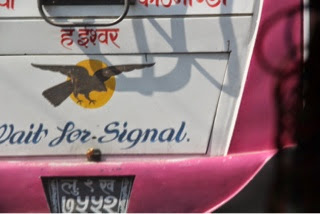 We hired a car to take us the 6 or 7 hours from pokhara to Kathmandu. The ride was a long series of harrowing escapes, passing the colorful trucks from India, with wide sayings and Hindu gods painted on the sides and back. When a truck needs to stop or breaks down, it just stops, mostly blocking one lane. Since we want to get to Kathmandu before midnight, we must pass on curving mountain roads. This is done by pulling out into the opposing lane, honking wildly and hoping there are no trucks hidden behind the next curve. I just concentrated on whatever wise advice was printed on the truck, which include the admonition to honk.
We hired a car to take us the 6 or 7 hours from pokhara to Kathmandu. The ride was a long series of harrowing escapes, passing the colorful trucks from India, with wide sayings and Hindu gods painted on the sides and back. When a truck needs to stop or breaks down, it just stops, mostly blocking one lane. Since we want to get to Kathmandu before midnight, we must pass on curving mountain roads. This is done by pulling out into the opposing lane, honking wildly and hoping there are no trucks hidden behind the next curve. I just concentrated on whatever wise advice was printed on the truck, which include the admonition to honk. We stop at a roadside dinner where they have a hot buffet of, what else? Dal baht.
 The next day we went to my favorite monastery, kind of like temple square, except it is a circle, very ole, surrounded by building and shops. We had lunch on the rooftop cafe and watched the prayer flags wave in the breeze.
The next day we went to my favorite monastery, kind of like temple square, except it is a circle, very ole, surrounded by building and shops. We had lunch on the rooftop cafe and watched the prayer flags wave in the breeze. Kathmandu and Nepal are full of rich contrasts, new construction, crumbling buildings, crowded store fronts, piles of junk, cows wandering around,dusty unpaved roads, brilliantly colored skirts and dresses, ceaseless honking, bad air on the street, dogs lying about, playful children, school children walking in pairs in uniforms of dark skirts or pants and white shirts. There are secreted along the city streets Hindu and Buddhist shrines and monks going about the business of being monks. Everywhere are little storefronts selling both remarkably similar and widely varying arrays of goods. Young men in grey or black jackets ride motorcycles with young women on the back clothed in bright colors and red lipstick. Above the traffic and noise and dust bird fly about and sing in the trees. have bcome accustomed to the place, it just seems like this is the way the world is.
Kathmandu and Nepal are full of rich contrasts, new construction, crumbling buildings, crowded store fronts, piles of junk, cows wandering around,dusty unpaved roads, brilliantly colored skirts and dresses, ceaseless honking, bad air on the street, dogs lying about, playful children, school children walking in pairs in uniforms of dark skirts or pants and white shirts. There are secreted along the city streets Hindu and Buddhist shrines and monks going about the business of being monks. Everywhere are little storefronts selling both remarkably similar and widely varying arrays of goods. Young men in grey or black jackets ride motorcycles with young women on the back clothed in bright colors and red lipstick. Above the traffic and noise and dust bird fly about and sing in the trees. have bcome accustomed to the place, it just seems like this is the way the world is. 



















































